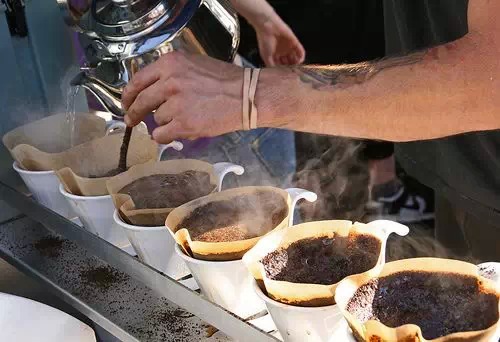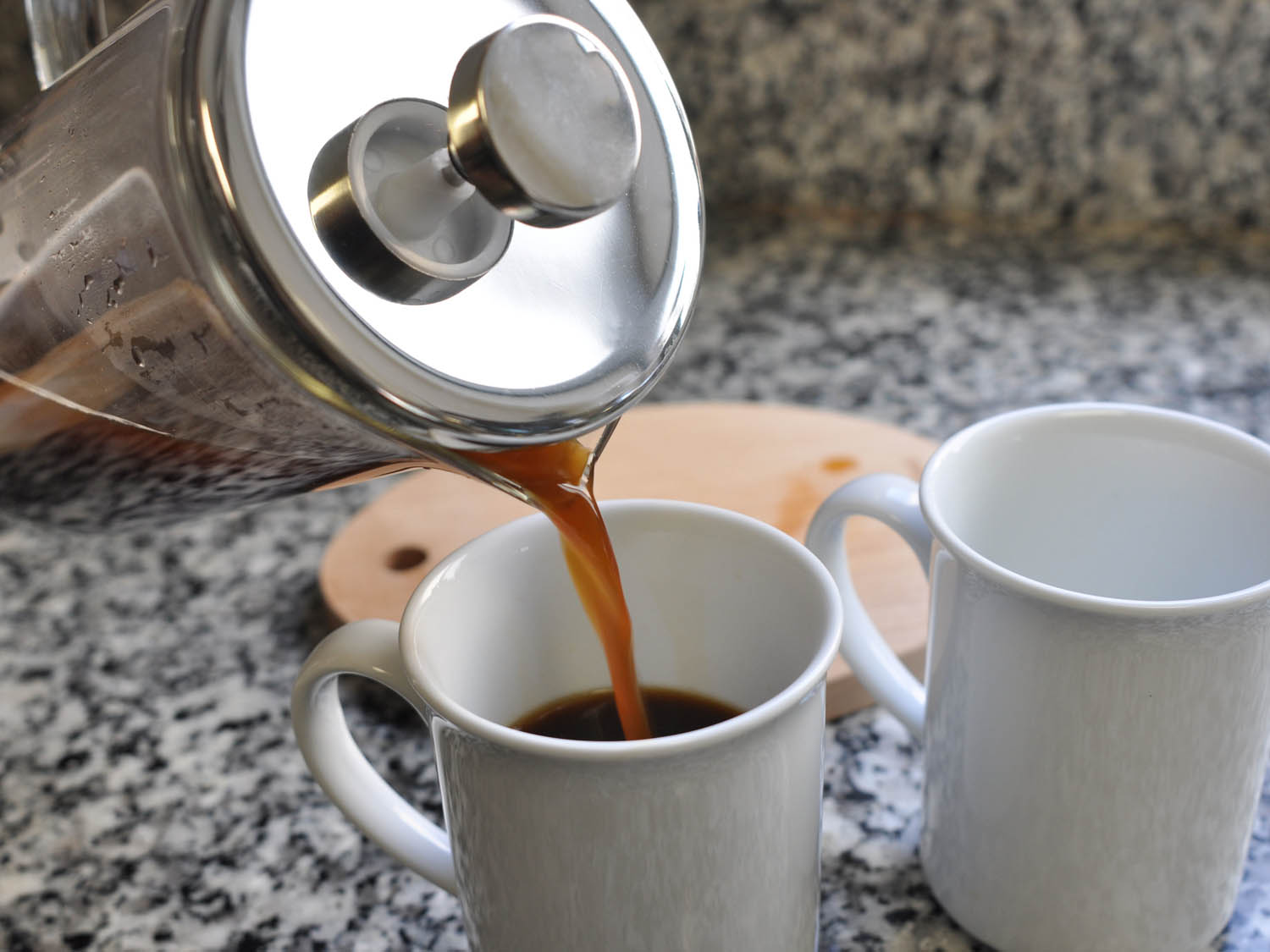Coffee knowledge; seven factors affecting the flavor and aroma of coffee raw beans
Follow the caf é (Wechat official account vdailycom) and found that Beautiful Cafe opened a small shop of its own.
60% of a good cup of coffee depends on the quality of raw beans. As a coffee practitioner, we should open up the pattern and learn more about the whole link of "From Seed To Cup" as much as possible. This is helpful to the link you are engaged in. After all, bakers bake according to beans, while baristas use beans and baking ideas.
We know that scientists have extracted thousands of aromatic substances from raw coffee beans, and different coffees have different flavors and aromas. So what are the reasons that determine the difference in coffee?

I. different places of origin
Different producing areas will have different temperature, rainfall, sunshine, humidity and soil composition. So even the same variety of coffee will be cultivated in different environments with different flavors and aromas. For example, the rose summer in Ethiopia is different from that in Panama, because coffee trees produce fruits with different flavors depending on the growth environment. Generally speaking, African beans taste bright and cheerful, and the flavor in the mouth is changeable and lively; Central and South American beans are enthusiastic and unrestrained, with only a mouthful of all the flavors coming; Asian beans are relatively conservative and need to be extracted at high temperature for a long time. Figure it out slowly. I have to say, beans are like people.
Second, different varieties
Different places of production, even different estates, the varieties of coffee will be different, so the cultivated varieties of coffee are also very diverse, of course, the taste and aroma of coffee are also varied. There are thousands of coffee tree species all over the world, and the more common species are as follows:
Iron card species (Typica):
Have superior aroma and mild sour taste
Bourbon species (Bourbon)
The thickness, aroma and sweetness of the concentrated alcohol are very bright.
Kaddura species (Caturra):
Refreshing sour fruit, light sweetness.
Kadimo species (Catimor):
Bitter taste, dark chocolate aroma.
Canefra (Canefora):
Can also become Robusta, taste single, mugi-cha fragrance.
Third, different treatment methods
Coffee berries are processed after picking. Typical treatment methods are as follows:
one
Sun treatment (Natural)
two
Washing method (Washed)
three
Semi-washing method (Semi-washed)
four
Natural pectin removal (Pulped Natural)
-Red honey (Red Honey)
-Yellow honey (Yellow Honey)
-Black honey (Black Honey)
Sweet & mellow thickness:
Sun exposure > natural pectin removal > semi-washing > water washing
Acidity & aroma:
Washing with water > semi-washing > natural removal of pectin > solarization
Solarization is the oldest treatment method, which is not only time-consuming, but also easy to produce defective beans. The water washing method is to make up for the defects of the sun method and was born. The washing method saves time, reduces the occurrence rate of defective beans, and then controls the quality of coffee. However, the flavor and alcohol thickness of coffee processed by washing method are not as good as those processed by tanning method. As a result, people invented the honey treatment, that is, the natural removal of pectin, that is, the peel was removed and the pulp was preserved for drying.
Fourth, planting at different elevations
For people who grow fine coffee, in order to be similar to the acidity of fruit and have deep dry aroma of coffee, it is found that the area suitable for growing fine coffee is the plateau with an altitude of 1500 meters to 2000 meters above sea level. Because there is a large temperature difference between day and night, the amount of oxygen absorbed by plants increases and the coffee fruit shrinks more frequently. But there are exceptions to this fact. In the Kona region of Hawaii, coffee beans are grown at an altitude of about 700 to 1,100 meters, because Hawaii has a unique island climate, excellent sun conditions, and usually modern facilities. farmers are so rich that they all have feelings and integrity.
High altitude:
Over 1400 m-SHB (Strictly Hard Bean) / SHG (Strictly High Grown)
1200 ~ 1400m-HB (Hard Bean) / HG (High Grown)
Mid-altitude area:
600m-900m-PW (Prime Washed)
Low altitude areas:
Below 600m-GW (Good Washed)
Fifth, regional coffee grade standards are different
Coffee grades from different places also have different classification criteria. Basically, there are four criteria for scoring raw coffee beans:
1. Planting altitude
2. Size of raw beans (sieve size Screen size)
3. Coffee bean flavor
4. Proportion of defective beans
But different countries have different benchmarks. In Brazil, for example, the criteria for taste are as follows (from high price to low price):
Strictly Soft > Soft > Softish > Hard > Hardish > Rioy > Rio
There are about four kinds of defective beans in coffee:
Over-fermented beans: spicy, astringent, sour and bitter.
Black beans: smelly and bitter.
Worm-eaten beans: smelly feet, rotting corpses.
Moldy beans: mildew, rot, bitterness.
6. The new and old degrees of raw beans are different
With the same kinds of beans, manors, elevations and planting methods, there is a great difference between new raw beans and old beans in dry and wet fragrance. Because coffee is also a kind of crop, freshness is very important for coffee.
The change of freshness of raw beans is as follows: new season beans > overgrown beans > old beans > aged beans.
Newly produced seasonal beans:
Raw beans harvested within a year
Overyielding seasonal beans:
More than one year
Lao Dou:
More than two years
Chen Niandou:
Ripe raw beans.
In terms of water content, the processed raw beans contain about 11-13% moisture. The longer the storage time is, the moisture will be gradually lost. For example, after a year at room temperature, the water content of raw beans will drop to less than 10%. The color of raw beans just processed is blue-green / green, but as time goes on, the color of raw beans will gradually become light green, white or yellow. And with the extension of raw frying, the aroma of raw beans will change from grass and spice to hay or rice, and for a longer time, it will be completely tasteless.
7. Different ways of preservation
No matter how good the quality of raw beans is, they will vary according to different preservation methods and facilities. The ideal thing is to maintain an indoor temperature of 15,18 degrees Celsius and an indoor humidity of 50% and 60%. The wrong way of preservation will affect the flavor and aroma of beans, and even deteriorate. It often causes raw beans to fade and whiten and become wet and soft.
White or yellow raw beans:
Because the temperature of the storage place is too high, or too dry, the moisture of raw beans will be sucked away by air.
Raw beans with a moist surface:
The humidity of the storage place is too high, the rainy season. If the condition is serious, mold will appear on the surface of the beans.
Important Notice :
前街咖啡 FrontStreet Coffee has moved to new addredd:
FrontStreet Coffee Address: 315,Donghua East Road,GuangZhou
Tel:020 38364473
- Prev

Several common mistakes in hand-made coffee must be seen by beginners.
Following Kaiping (official Wechat account vdailycom) found that Beautiful Cafe opened a small shop of its own. Many friends said, "Why can't you make a good cup of hand-made coffee even though you have followed the steps?" Now the editor exposes the common mistakes of making coffee from three angles! A good cup of hand-brewed coffee can taste different levels of details, such as sour, fragrant, sweet and so on.
- Next

Coffee making: how to make perfect French Coffee at Home
Following Ka Pin (Wechat official account vdailycom) found that Beautiful Cafe opened a small shop of its own, making pots, which were ordinary but extraordinary. The French kettle is like Man 2 in the movie. Although the heroine is attracted by the glamorous male 1, she doesn't realize that male 2 is actually the one. The French kettle does not have any high technology or luxurious appearance, but the coffee made from it
Related
- What is the meaning of lactic acid fermentation with coffee bean treatment?
- How to judge the state of foam by sound?
- How does the latte pull out the unicorn pattern? Come to get for a little trick to improve the flower pull!
- Will flower pulling affect the taste of the latte?
- Do you know the history of coffee?
- The difference between honey treatment and sun washing what is raisin honey treatment?
- What kind of milk can a novice use to make coffee foam to keep the foam longer? The correct method and skills of milking tutorial sharing
- Why do washed coffee beans taste sour? Flavor characteristics of washed Coffee
- Introduction to the skill of how to practice the size and height of water injection around the circle of hand-brewed coffee
- How do beginners practice coffee flower drawing from scratch?

